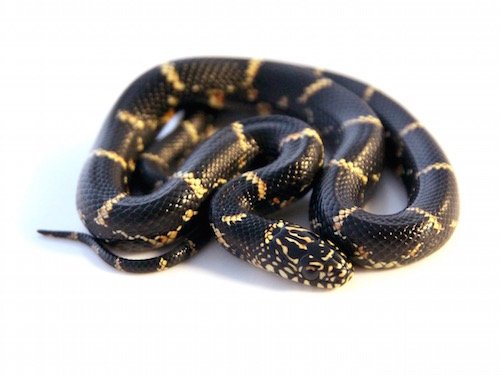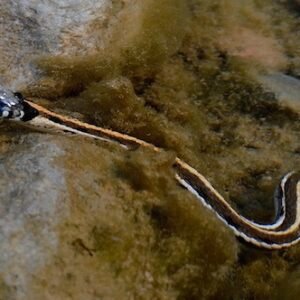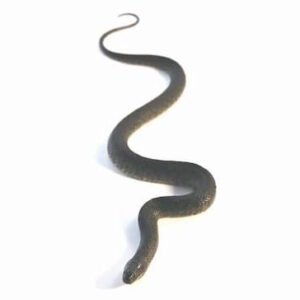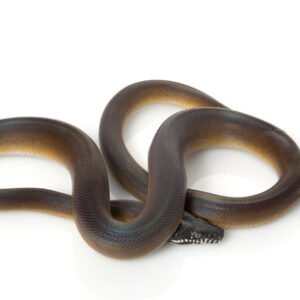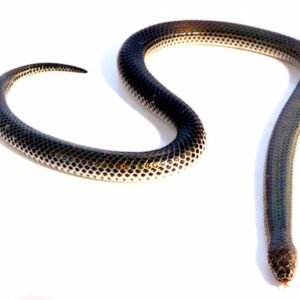Introduction to the Eastern King Snake
The Eastern King Snake, scientifically known as Lampropeltis getula, is a non-venomous snake species endemic to the eastern United States. This species falls under the family Colubridae and is widely recognized for its striking appearance and docile temperament, making it a popular choice among reptile enthusiasts and pet owners. The Eastern King Snake typically showcases a remarkable color pattern, which includes a glossy black base adorned with white or yellow banding, although variations do exist, including entirely black morphs. This unique coloration not only adds to the Eastern King Snake’s appeal as a pet but also serves as a form of camouflage within its natural habitat.
In terms of physical characteristics, the average Eastern King Snake can reach lengths of 3 to 4 feet, though some individuals can grow even larger. They possess a robust, muscular body, which is complemented by their distinctive smooth scales. These snakes are known for their impressive ability to constrict their prey, a trait that has evolved as a survival mechanism. In the wild, their diet primarily consists of small mammals, birds, and even other snakes, allowing them to play an essential role in their ecosystem by controlling the populations of these species.
Behaviorally, the Eastern King Snake is primarily diurnal, meaning it is most active during daylight hours. They exhibit a curious nature, often exploring their surroundings when prompted. These snakes are also known for their adaptability to various environments, including forests, grasslands, and even suburban areas. With the combination of their fascinating physical traits and engaging behaviors, the Eastern King Snake stands out amongst its relatives, often serving as an ambassador for the understanding and preservation of snakes in general.
Habitat and Distribution
The Eastern King Snake (Lampropeltis getula) is predominantly found throughout the southeastern and eastern regions of the United States. Its extensive distribution includes states from Florida to Maine, showcasing a remarkable range of adaptability across diverse environments. This non-venomous snake thrives in various habitats, including forests, grasslands, wetlands, and suburban areas, reflecting its flexible ecological nature.
In forested areas, Eastern King Snakes favor habitats that provide ample cover and hunting opportunities. They can often be spotted near edges of woodlands where sunlight filters through the trees. This juxtaposition of sunny patches and shaded regions creates an optimal hunting ground for these snakes, as they primarily feed on small mammals, birds, and other reptiles. Grasslands also serve as a vital habitat, where they utilize their adept climbing skills to navigate low vegetation and hunt for prey.
In suburban environments, Eastern King Snakes have adapted remarkably well. They are commonly found in gardens, parks, and yards, where they can find shelter under debris, wood piles, or rocks. This adaptability to human-altered landscapes demonstrates their versatility, as they can exploit a range of prey items, even living closely alongside humans. They often utilize artificial structures for basking and ambushing prey, making them an intriguing element of the local ecosystem.
Factors influencing habitat preferences include temperature, moisture, and the availability of prey. The Eastern King Snake is particularly sensitive to environmental changes, which can impact its distribution. For instance, they may migrate in response to seasonal variations in temperature or changes brought on by urban development. This adaptability is a testament to their resilience and contributes to their ongoing presence across various landscapes in the eastern United States.
Diet and Hunting Behavior
The Eastern King Snake (Lampropeltis getula) exhibits a diverse diet primarily composed of small mammals, other snakes, lizards, and even bird eggs. This adaptability in dietary preferences allows the Eastern King Snake to thrive in various habitats, from forests and grasslands to suburban areas. Rodents, particularly mice and rats, form a substantial part of their diet, making them crucial in controlling these populations and maintaining ecological balance.
Hunting techniques employed by the Eastern King Snake are multifaceted. These snakes are known for their exceptional ability to constrict prey, ensuring quick and efficient kills. They typically pursue smaller prey items through active hunting, where stealth and cunning play significant roles. Ambush strategies are also common, wherein Eastern King Snakes remain motionless, relying on their camouflage to approach unsuspecting prey. When the moment is right, they strike with remarkable speed, securing their meals with a swift bite.
The adaptability of the Eastern King Snake extends beyond its hunting techniques; they are known to exhibit cannibalistic behaviors, occasionally consuming other snakes, including venomous species, which showcase their dominant role in the predator hierarchy. This behavior not only highlights their status as apex predators within their environments but also emphasizes their importance in controlling local snake populations, thereby contributing to ecosystem health.
Overall, the Eastern King Snake’s dietary habits and hunting behaviors underscore its vital role in the environment. By regulating rodent and snake populations, this versatile predator helps maintain the balance necessary for a healthy ecosystem, showcasing the interconnectedness of species within their habitats. Through understanding these behaviors, we gain appreciation for the ecological significance of the Eastern King Snake.
Care and Keeping in Captivity
The Eastern King Snake (Lampropeltis getula) has gained considerable popularity in the pet trade due to its manageable size, striking appearance, and docile temperament. To ensure a healthy life for these captivating reptiles, prospective owners must understand their specific care requirements thoroughly.
When setting up a habitat for your Eastern King Snake, the enclosure should ideally be a secure glass terrarium, with a minimum size of 20 gallons for a juvenile snake and larger for adults. Providing appropriate heating is crucial, as these snakes require a gradient ranging from 75°F to 85°F on the cool side and 85°F to 90°F on the warm side. Utilization of heat mats or basking lamps can help maintain these temperatures. Additionally, a humidity level of 40-60% is essential, which can be achieved through regular misting and a water bowl that is large enough for soaking.
Diet plays a major role in the overall health of the Eastern King Snake. In captivity, they primarily consume appropriately sized rodents, such as mice or rats. It is important to ensure that the prey is thawed if using frozen food, and that feeding occurs every 7 to 10 days to align with their natural feeding habits. Offering variety in their diet can prevent nutritional deficiencies.
Handling should be approached with care and consistency, particularly for younger snakes to build trust and reduce stress. It is recommended to limit handling during shedding periods or after feeding for a couple of days. Owners should also monitor their snake closely for signs of common health issues, such as respiratory infections or mites, to maintain their health. With proper care, the Eastern King Snake can be a remarkable and long-lived companion in your home.

